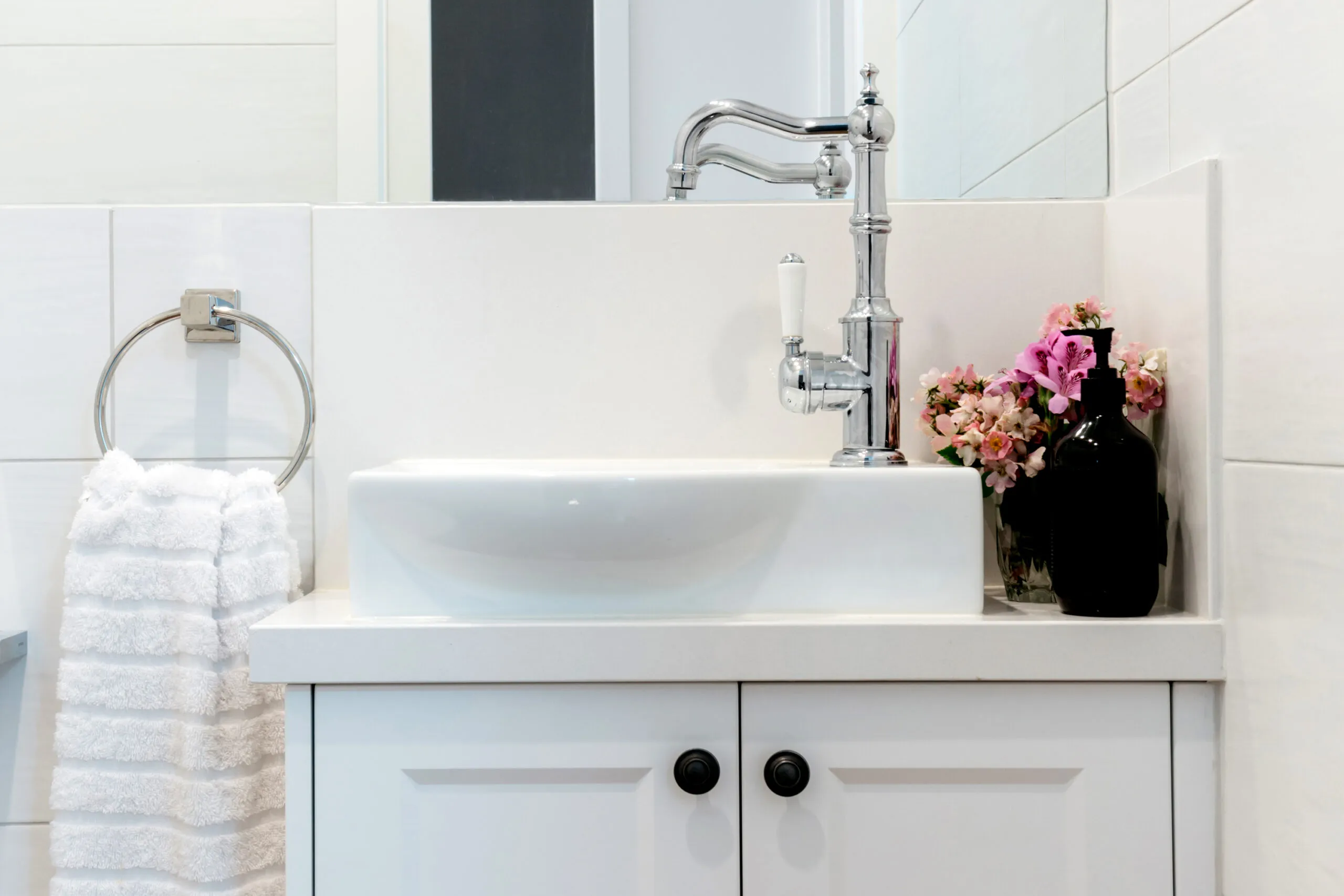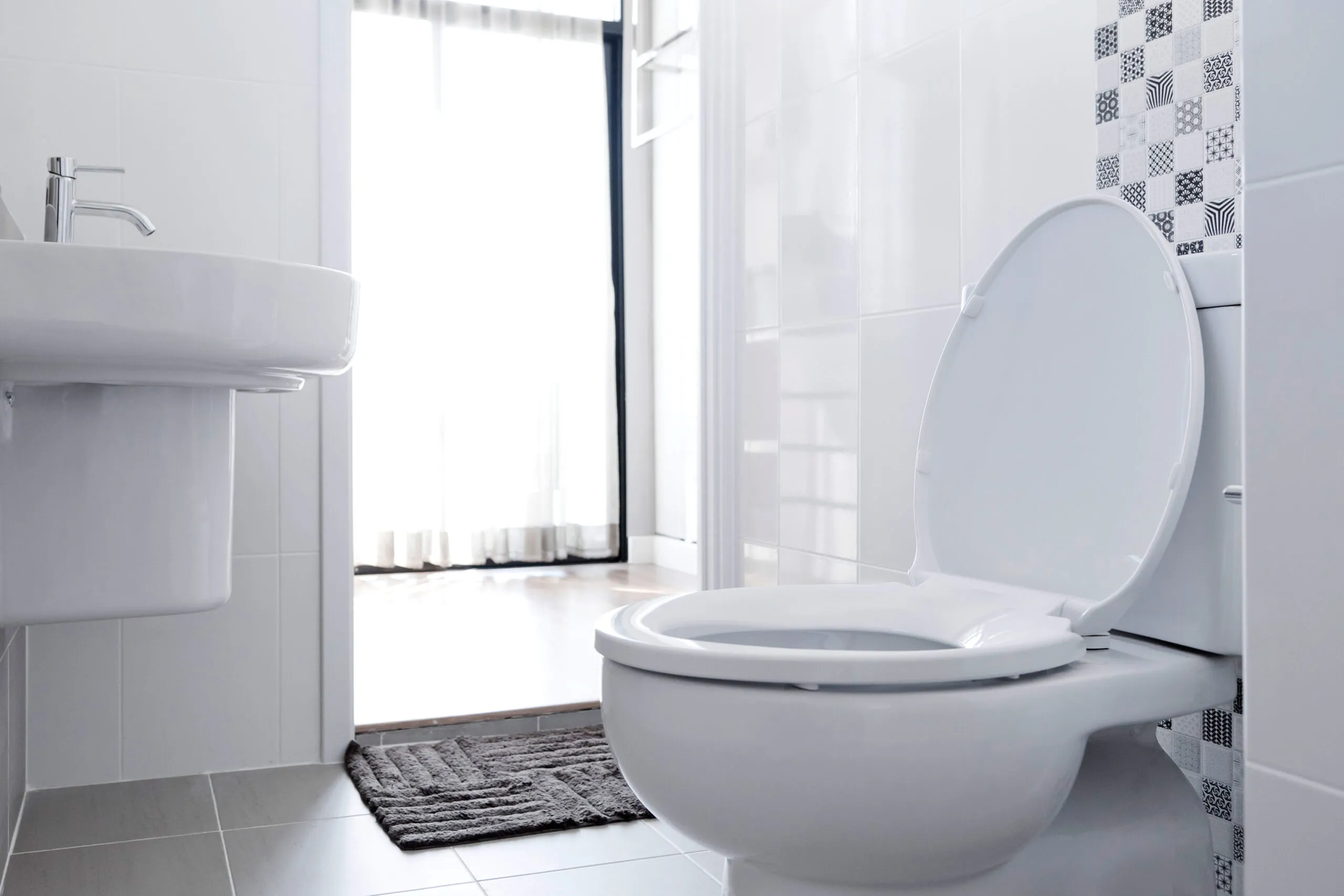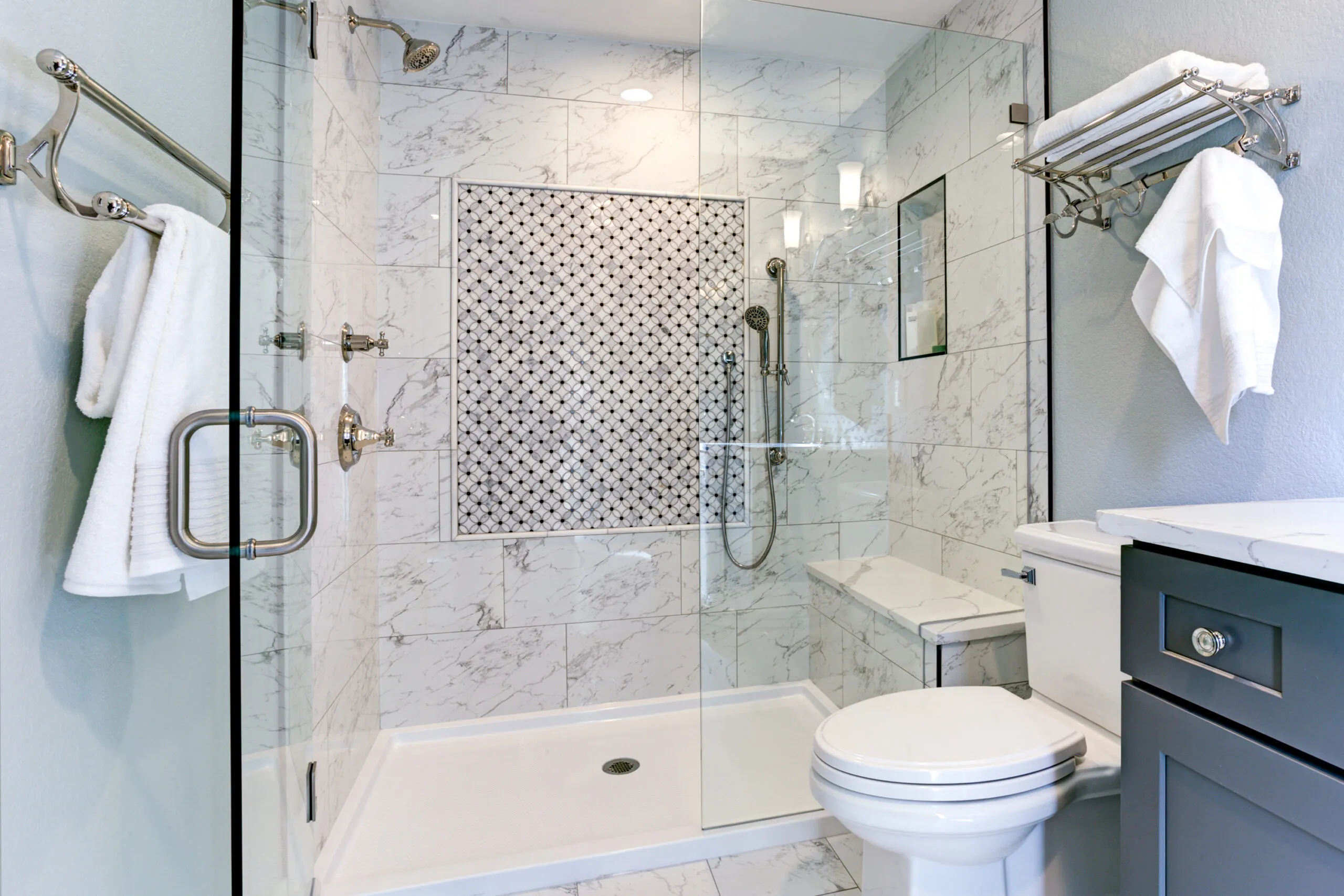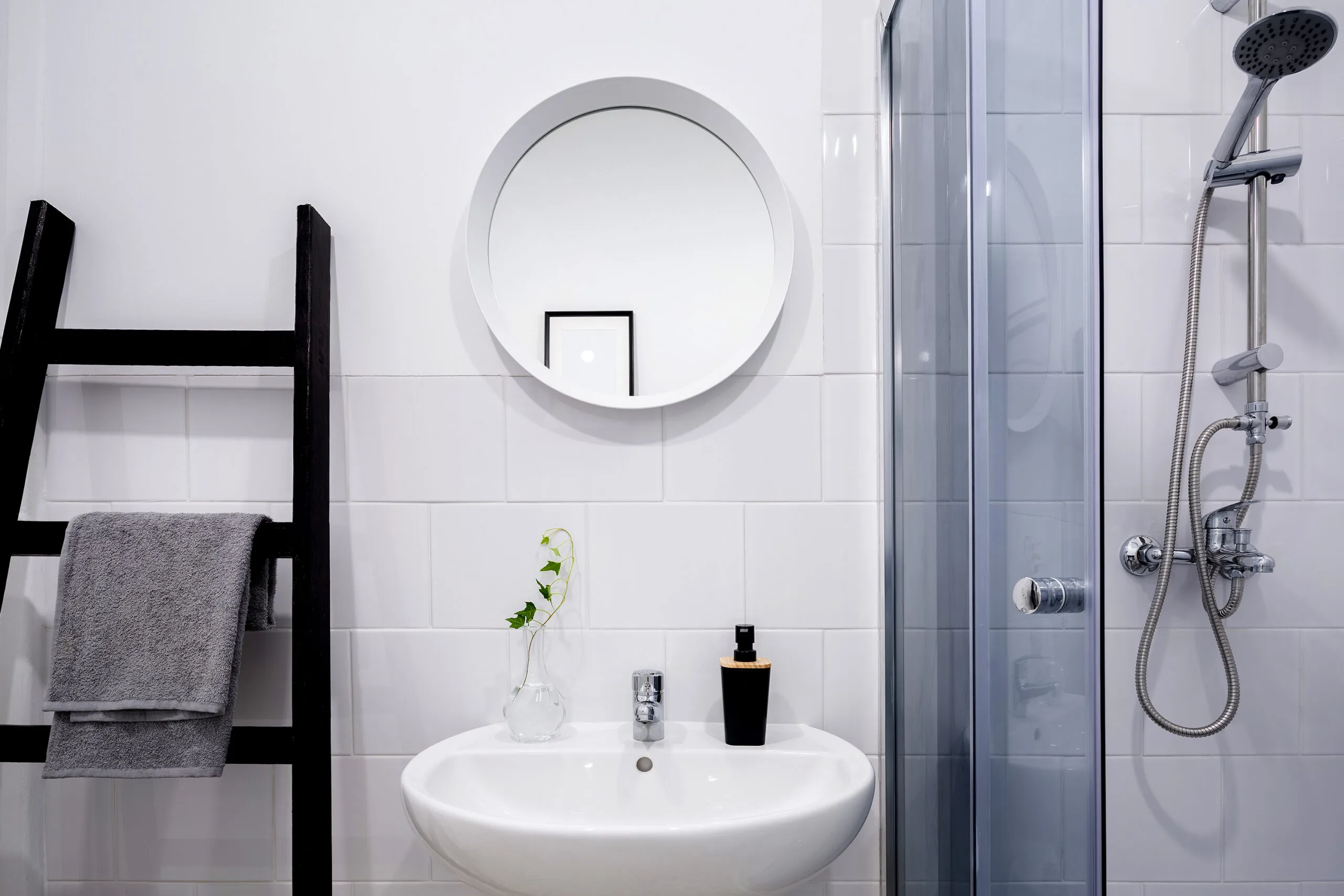Remodeling a small bathroom can be challenging, but with careful design planning and proper execution, even the tiniest spaces can be transformed. Our guide will walk you through how to maximize space and style in your small bathroom, from choosing compact fixtures to implementing clever storage solutions.
Planning Tips for Small Bathroom Remodels
Small bathrooms present challenges that require creative solutions. Limited square footage can make it difficult to fit all the necessary features while maintaining a comfortable and functional area. Homeowners often struggle with inadequate storage and a cramped feel. But with thoughtful design choices, you can plan effectively and address any challenges head-on for a successful remodel.
Start with a clear vision and a detailed plan. Measure your space accurately and take note of where existing plumbing and electrical lines are. When measuring, account for clearance space for movement and fixtures you want installed.
Multifunctional elements that serve dual purposes, such as a vanity with built-in storage, are perfect for small spaces. Using wall space for storage or visual interest can dramatically open up the room, whether that’s through shelving or artwork.
Choosing Space-Saving Bathroom Fixtures
Selecting the right fixtures when remodeling can significantly improve your bathroom’s functionality and space.
Compact Sinks and Vanities
Finding the right sink or vanity can be a game-changer for small bathrooms. “The smaller the lav, the more attention you must pay to the location and size of the faucet,” says Martha Kerr, a certified kitchen and bath designer with Neil Kelly Remodelers in Beaverton, Oregon. “It’s important to know before you choose a sink whether you can actually get your hands in there for washing!”
Wall-hung, corner, and pedestal sinks are great options for maximizing space, though these models don’t always come with built-in storage cabinets. Compact vanities are available for those who need storage. While standard vanities measure around 21 inches from front to back, space-saving vanities can measure 16 inches deep or less.

Space-Efficient Toilets
Toilets take up valuable space in a small bathroom, but compact options are available. Dimension, seat shape, and tank design all affect a toilet’s size. Round-front toilets typically extend 25 to 28 inches from the wall, while elongated toilets extend 29 to 31 inches. For a compromise between comfort and space-saving, compact elongated bowls are a good option.

Small Bathtubs and Shower Options
While standard bathtubs are 5 feet long and 30 to 32 inches wide, smaller options are available for tighter spaces. For homeowners who prefer showers, customized options can fit almost any dimension, though most codes require a minimum width of 32 inches. Corner showers are an excellent choice for small bathrooms.
Maximizing Bathroom Functionality and Storage
Maximizing storage in a small bathroom requires creative thinking. Use vertical space by adding tall, narrow cabinets or open shelving that can be mounted onto a wall. Over-the-toilet storage units can provide space without taking up usable floor area. Consider recessed medicine cabinets for more depth without taking up open space in the room.
Magnetic strips are another good hack because they can attach anywhere and hold small metal items like tweezers and nail clippers. These eliminate the need for or at least free up space in drawers. Over-the-door organizers or hooks can hold towels, robes, or toiletry bags, further contributing to a clutter-free space.
Stackable baskets, clear storage containers, and multifunctional furniture are other efficient options for enhancing storage without affecting the bathroom’s style.
A sliding barn-style door or a pocket door can be a space-saving alternative as opposed to a swinging door. Foldable or multiuse furniture, such as stools that double as storage bins, can help you make the most of limited square footage.
Design Layouts for Small Bathrooms
Consider the flow of movement within your bathroom while ensuring there’s enough clearance around fixtures you may want to install.
Utilizing corners can significantly increase the usable space in a small bathroom. Corner sinks, toilets, or showers are all convenient ways to free up wall and floor footage for other fixtures or storage while having essential appliances in your bathroom.
Wall-mounted fixtures can create the illusion of more floor space and make cleaning easier. Wall-hung toilets and sinks are excellent options for small bathrooms.
Floating vanities, unique wallpapers, and accent lighting are common choices to add personality. Matte black fixtures and mixed metals add visual interest without overwhelming the smaller space.
While sometimes more expensive, technological innovations like smart mirrors with built-in lighting can eliminate the need for additional light fixtures, blending convenience with a modern appliance and design.
Lighting Techniques To Create the Illusion of Space in the Bathroom
Proper lighting can make a small bathroom feel more spacious and inviting. Combining ambient, task, and accent lighting can create depth and dimension. Wall lamps on either side of the mirror provide even facial lighting while freeing up counter space. We also suggest recessed lighting for a clean, uncluttered look that can illuminate an entire bathroom.
If applicable, natural light through windows or skylights can brighten the space and make it feel larger. Reflective surfaces, such as glossy tiles or large mirrors, can also enhance your room’s brightness, making it appear bigger.
Color Schemes and Materials for a Spacious Bathroom Feel
The right color scheme and materials can make your bathroom feel bigger. Light, neutral colors reflect more light and make the space feel open and airy. Consider using large-format tiles or continuous materials like sheet vinyl to minimize grout lines and create a more seamless look. Mirrors can also help amplify light and create the illusion of more space.
A single-color floor and walls that blend with the fixtures make a small bathroom feel less cluttered. This cohesive look can make the space feel larger and more unified. Additionally, incorporating glass doors for showers instead of curtains can further create a sense of spaciousness.
Budget-Friendly Small Bathroom Upgrades
Remodeling a small bathroom doesn’t have to break your bank. There are many high-impact changes that don’t require moving plumbing or electrical lines. Updating hardware, refinishing your cast iron tub, or installing a new vanity top can refresh the space without a complete overhaul.
Paint is also an inexpensive way to transform the look of your bathroom. Upgrading to energy-efficient fixtures and proper insulation can help reduce long-term costs while enhancing your bathroom’s functionality.

DIY vs. Professional Remodeling for Small Bathrooms
Deciding whether to tackle a small bathroom remodel yourself or hire a professional depends on your skills, budget, and the scope of the project. Simple upgrades like painting, replacing hardware, or installing a new toilet are often within the realm of DIY. However, more complex tasks involving plumbing, electrical work, or structural changes are best left to professionals.
Consider consulting with a bathroom designer or contractor for advice on layout and fixture selection, even if you plan to do some of the work yourself. Assess your limitations realistically to avoid costly mistakes that could damage your bathroom and push back your remodeling timeline.
Realistic Timelines for Small Bathroom Renovations
Making a timeline for a small bathroom renovation can help you plan effectively and minimize disruption to your daily life. When your remodel comes together, the finished product will likely take 5–9 weeks to complete.
Planning and Design Phase
The planning and design phase typically takes 2–4 weeks. This includes measuring the space, researching fixtures and materials, and finalizing your design plan. This is arguably the most important phase in your remodeling process, as you can take multiple different design routes. Staying within your budget is also an important part of the planning process.
Demolition and Construction
Demolition and construction for a small bathroom usually take 2–3 weeks. This phase includes removing old fixtures, updating plumbing and electrical as needed, and installing new fixtures and finishes. The timeline can vary depending on the complexity of the project and any unforeseen issues that may require a professional.
Finishing Touches
Allow 1–2 weeks for finishing touches like painting, installing accessories, and final clean-up. This phase brings your vision to life and perfects every detail. Small touches such as new towels, soap dispensers, and decorative items can make a big difference in your bathroom’s overall look.
Common Small Bathroom Remodeling Obstacles
Limited storage, poor ventilation, and awkward layouts are common challenges for small bathrooms. You can easily address storage issues with creative solutions like recessed shelving or over-toilet cabinets. Ventilation can be improved by installing a properly sized exhaust fan to prevent moisture issues.
Custom-sized fixtures or unconventional placements can help you make the most of the space for awkward layouts. Planning for accessibility, such as installing grab bars and anti-slip flooring, can also help guarantee the safety and usability of your small bathroom.
Our Conclusion
Remodeling a small bathroom presents unique challenges, but with careful planning and creative solutions, you can create a space that is both functional and stylish. Maximize every inch of your bathroom by choosing space-saving fixtures, implementing clever storage solutions, and using an optimal layout.
Consider lighting, color schemes, and materials that create the illusion of more space. With the right approach, even the smallest bathroom can become a beautiful and efficient space in your home.

